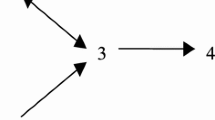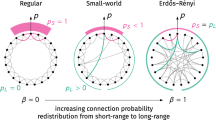Abstract
In order to explain the ability of individuals to find short paths to route messages to an unknown destination, based only on their own local view of a social network (the small world phenomenon), Kleinberg (2000) proposed a network model based on a d-dimensional lattice of size n augmented with k long range directed links per node. Individuals behavior is modeled by a greedy algorithm that forwards the message to the neighbor of the current holder, which is the closest to the destination. This algorithm computes paths of expected length Θ(log2 n/k) between any pair of nodes. Other topologies have been proposed later on to improve greedy algorithm performance. But, Aspnes et al. (2002) shows that for a wide class of long range link distributions, the expected length of the path computed by this algorithm is always \(\Omega\big(\log^2 n/(k^2\log\log n)\big)\).
We design and analyze a new decentralized routing algorithm, in which nodes consult their neighbors near by, before deciding to whom forward the message. Our algorithm uses similar amount of computational resources as Kleinberg’s greedy algorithm: it is easy to implement, visits \(O\big(\log^2n/\log^2(1+k)\big)\) nodes on expectation and requires only Θ(log2 n/log(1+k)) bits of memory ⊢ note that [1] shows that any decentralized algorithm visits at least Ω(log2 n/k) on expectation. Our algorithm computes however an almost optimal path of expected length \(O\big(\log n(\log \log n)^2/\log^2(1+k)\big)\), between any pair of nodes. Our algorithm might fit better some human social behaviors (such as web browsing) and may also have successful applications to peer-to-peer networks where the length of the path along which the files are downloaded, is a critical parameter of the network performance.
This works was supported by the CNRS AS Dynamo and AS Grands Graphes grants.
Access this chapter
Tax calculation will be finalised at checkout
Purchases are for personal use only
Preview
Unable to display preview. Download preview PDF.
Similar content being viewed by others
References
Manku, G.S., Naor, M., Wieder, U.: Know thy neighbor’s neighbor: The power of lookahead in randomized P2P networks. To appear in Proc. of 36th ACM STOC 2004 (2004)
Milgram, S.: The small world problem. Psychology Today 61 (1967)
Newman, M.E.J.: Models of the small world. J. Stat. Phys. 101 (2000)
Newman, M.E.J.: The structure and function of complex networks. SIAM Review 45, 167–256 (2003)
Zhang, H., Goel, A., Govindan, R.: Using the small-world model to improve Freenet performance. In: Proceedings of IEEE INFOCOM (2002)
Aspnes, J., Diamadia, Z., Shah, G.: Fault-tolerant routing in peer-to-peer systems. In: Proc. of ACM 3st Symp. on Princ. of Distr. Comp (PODC 2002), vol. 31, pp. 223–232 (2002)
Watts, D., Strogatz, S.: Collective dynamics of small-world networks. Nature 393 (1998)
Newman, M.E.J., Moore, C., Watts, D.J.: Mean-field solution of the small-world network model. Phys. Rev. Lett. 84, 3201–3204 (2000)
Bollobás, B., Chung, F.: The diameter of a cycle plus random matching. SIAM J. Discrete Math. 1, 328–333 (1988)
Kleinberg, J.: The small-world phenomenon: an algorithmic perspective. In: Proc. 32nd ACM Symposium on Theory of Computing, pp. 163–170 (2000)
Barrière, L., Fraigniaud, P., Kranakis, E., Krizanc, D.: Efficient routing in networks with long range contacts. In: Welch, J.L. (ed.) DISC 2001. LNCS, vol. 2180, pp. 270–284. Springer, Heidelberg (2001)
Benjamini, I., Berger, N.: The diameter of long-range percolation clusters on finite cycles. Random Structures and Algorithms 19, 102–111 (2001)
Coppersmith, D., Gamarnik, D., Sviridenko, M.: The diameter of a long range percolation graph. Random Structures and Algorithms 21, 1–13 (2002)
Stoica, I., Morris, R., Karger, D., Kaashoek, M.F., Balakrishnan, H.: Chord: a scalable peer-to-peer lookup service for internet applications. In: Proc. of ACM SIGCOMM 2001 (2001)
Manku, G.S., Bawa, M., Raghavan, P.: Symphony: Distributed hashing in a small world. In: Proc. of 4th Usenix Symp. on Internet tech. and syst. (2003)
Fraigniaud, P., Gavoille, C., Paul, C.: Eclecticism shrinks the world. Technical Report LRI-1376, University Paris-Sud (2003)
Kleinberg, J.: Small-world phenomena and the dynamics of information. In: Advances in Neural Information Processing Systems, vol. 14, MIT Press, Cambridge (2002)
Author information
Authors and Affiliations
Editor information
Editors and Affiliations
Rights and permissions
Copyright information
© 2004 Springer-Verlag Berlin Heidelberg
About this paper
Cite this paper
Lebhar, E., Schabanel, N. (2004). Almost Optimal Decentralized Routing in Long-Range Contact Networks. In: Díaz, J., Karhumäki, J., Lepistö, A., Sannella, D. (eds) Automata, Languages and Programming. ICALP 2004. Lecture Notes in Computer Science, vol 3142. Springer, Berlin, Heidelberg. https://doi.org/10.1007/978-3-540-27836-8_75
Download citation
DOI: https://doi.org/10.1007/978-3-540-27836-8_75
Publisher Name: Springer, Berlin, Heidelberg
Print ISBN: 978-3-540-22849-3
Online ISBN: 978-3-540-27836-8
eBook Packages: Springer Book Archive




